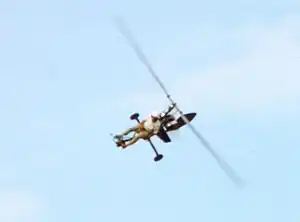| Brock KB-2 Freedom Machine | |
|---|---|
 | |
| Ken Brock at Oshkosh 2001 | |
| Role | Autogyro |
| National origin | United States of America |
| Manufacturer | Ken Brock Manufacturing |
| Designer | Ken Brock |
| First flight | 1970 |
| Developed from | Brock KB-1 Gyroplane |
The KB-2 Freedom Machine is an autogyro designed by Ken Brock based on the designs of the Bensen B-8.[1][2]
Design and development
Ken Brock was an early innovator in homebuilt gyrocopters starting with his first ride in 1957.[3] Brock set to work on building and marketing a series of homebuilt gyroplanes with the KB-1 and later the KB-2.[4]
Operational history
Ken Brock used his KB-2 design for years in airshow acts and completed several world records. In 1971 he completed the first coast-to-coast autogyro flight from Long Beach, California to Kitty Hawk, North Carolina.[5]
Variants
- KB-2
- Powered variant
- KB-2G
- Variant with the same frame and rotor head as a KB-2. The "glider" is a two-seat gyroplane designed to be towed by car. The aircraft with the same frame and rotor assembly can be converted to a powered gyroplane.[6]
Aircraft on display
A 1970 demonstrator KB-2 is in the EAA Airventure Museum in Oshkosh, Wisconsin
Specifications (KB-2)
Data from EAA
General characteristics
- Capacity: 1
- Empty weight: 240 lb (109 kg)
- Gross weight: 600 lb (272 kg)
- Powerplant: 1 × McCulloch 4318 , 90 hp (67 kW)
- Main rotor diameter: 2 × 12 ft (3.7 m)
Performance
- Cruise speed: 61 kn (70 mph, 110 km/h)
- Range: 520 nmi (600 mi, 970 km)
- Rate of climb: 1,900 ft/min (9.7 m/s)
See also
Aircraft of comparable role, configuration, and era
- Bensen B-8
- Midwest Hornet
- Taggart Gyrobee
- Wallis WA-116 Agile
References
Wikimedia Commons has media related to Brock KB-2.
- ↑ "Brock KB-2 Gyroplane". Archived from the original on 19 July 2011. Retrieved 29 March 2011.
- ↑ Downey, Julia: 2005 Trikes 'Chutes and Rotorcraft Directory, Kitplanes, Volume 22, Number 2, February 2005, page 57. Belvoir Publications. ISSN 0891-1851
- ↑ Henry Doering (1980). Book of buffs, masters, mavens, and uncommon experts.
- ↑ "Good Gyrations". Popular Science. November 1998.
- ↑ Popular Mechanics. Nov 1971.
{{cite journal}}: Missing or empty|title=(help) - ↑ Popular Science. February 1982.
{{cite journal}}: Missing or empty|title=(help)
This article is issued from Wikipedia. The text is licensed under Creative Commons - Attribution - Sharealike. Additional terms may apply for the media files.